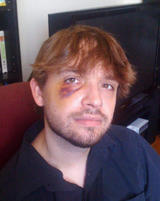
2011-05-25
The names of seven “John Doe” officers listed in Dorian Barton’s civil suit against the Toronto Police Services will soon be revealed, his lawyers say.
Barton, a 30-year-old cookie maker, suffered a broken right arm, black eye, swollen limbs and a bruised back when he was arrested near Queen’s Park during the G20 weekend.
The Special Investigations Unit has twice reviewed police actions in his arrest, and twice said it lacked evidence to lay charges — despite photo evidence and damning testimony from a civilian witness.
Now, Barton’s $250,000 civil suit against the Toronto Police Board and seven unidentified cops is his only remaining course of action.

“We’ll name the officers,” said Clayton Ruby, Barton’s lawyer, who expects to receive the information from either the SIU or the Toronto Police Services during pleadings in the civil case.
“They have to give answers, and they’ll give us the names of the officers.”
“It will pay off,” he said, confident in his client’s case. “But that doesn’t fix the problem of public justice.”
Last week, the Special Investigations Unit deemed it had insufficient evidence to lay charges against any police officers in the violent arrest of Barton during the G20 weekend.
This despite the fact that a nearby photographer, Andrew Wallace, witnessed the aggressive takedown.
“I’m really blown away and disappointed by this,” Wallace said Tuesday. “I practically served this officer up on a silver platter.”
Wallace said he witnessed the officer hit Barton with a baton, and started snapping photos immediately after.
“I don’t know how they can say that with a straight face,” the 36 year old said, of the SIU assertion that his testimony wasn’t enough. “I clearly identified the officer.”
Wallace came forward with the photos in January, two months after the SIU closed its initial investigation into Barton’s arrest.
Barton says he was taking pictures before being blindsided without warning by an officer with a riot shield.
Wallace snapped a photo of one the officers standing over Barton. He testified that he witnessed the officer striking him.
It wasn’t enough.
After 11 witness officers said they could not identify the officer in the picture, the SIU said it could not find reasonable grounds to lay charges.
“It’s just a failure of justice,” said Ruby.
“It’s enough evidence, unless there’s a police officer involved. It’s a complete double standard.”
Every day, charges are laid after one person witnesses the illegal action of another and points them out, Ruby said.
“These are reasonable, probable grounds in every court in the country,” he said, of Wallace’s first-hand identification of the officer. “And in this case it’s backed up by hard evidence — a photograph.”
The implication is that a civilian’s word is worthless unless a police officer corroborates it, he said.
“These are artificial barriers that protect the police from prosecution.”
Ian Scott, director of the SIU, says it’s more complicated than that. Courts are adverse to stranger identification testimony, he said.
Instead, he said, courts prefer evidence from people who know the accused, or forensic evidence, like DNA.
Because Wallace doesn’t know the officer standing over Barton in his picture, it would be difficult for him to identify the officer if he were charged and the case went to court, which would likely take more than a year, Scott said.
If another police officer had positively identified the officer in the photo, there would be a better chance to confirm his identity at a trial, Scott explained.
But none of the 11 witness officers summoned in the SIU’s review could identify the officer in the photograph as someone they recognized — despite the fact that eight of them were nearby when Barton was arrested.
“It’s not good enough,” Scott said, of Wallace’s singular, lonely identification of the officer. “You have to prove his identity through another route.
“All we need is someone to say I know the officer in that photograph, and that officer is officer ‘X’,” he said.
In January, Toronto Police provided the SIU with the badge number and name of the officer in Wallace’s photo, said police spokesman Mark Pugash. They’ve provided it twice more since then, he said.
“They did provide us with that information,” Scott said. “However, they did not provide us with the method they used to get that information.”
Pugash says they zoomed in on the photo, and wrote it down.
Scott says the SIU tried that too — but were unable to clearly view a badge number in the picture, despite borrowing data recovery technology from the Ministry of Revenue.
“If Chief Blair wants to provide us with the name of an officer or employee that can help us with that . . . we would interview them and reassess the case.”
Without that link, Scott says the case is too weak on Wallace’s evidence alone. If more evidence comes in, the SIU will reopen the investigation for a third time.